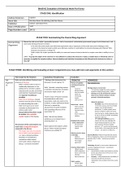BHASVIC Evaluation of Historical Work Pro-Forma
STAGE ONE: Identification
Author/Historian Gaddis J
Work Title We Now Know: Re-thinking Cold War history
Publisher Oxford: clarendon Press
Date of Publication 1997
Page Numbers used 24-51
STAGE TWO: Summarising the Overarching Argument
Overarching Blames the cold war on Stalin’s personality (paranoia + lack of concessions), authoritarian government (purges, lack of democracy), and
communist ideology (Marxist-Leninism)
Argument - In his view the soviet empire was inherently expansionist and an expression of the soviet state and its ideology on the
contrary to the American empire which was a defensive reaction in contradiction to American ideology and reflected “little
imperial consciousness or design”39
- Stalin’s desire for empire preceded his ability to create one however Americas desire for empire came after its ability to do so
33
Leffler “To grasp the origins of the Cold war it is not sufficient to analyse the structures created, as Gaddis does so effectively, but it is
necessary to explain the complex motives, diverse intentions and turbulent circumstances that allowed such structures to evolve as
they did”
STAGE THREE: Identifying and Evaluating at least 4 Arguments (you may add more sub-arguments in this section)
Point made by the historian Quotations/Paraphrasing Evaluation
Sub Stalin and other officials (Molotov) were “Ideology often determined the STRENGTHS WEAKNESSES
Argument prisoners of ideology behaviour of such regimes”31 The fear of capitalist Post revisionist view
(1) - Stalin’s actions made no sense in encirclement based on
traditionally diplomatic or Geo- events,
Stalin “devoted a surprising amount Ideology played a ‘second role’
political terms. Kremlin’s policies - based on
of attention showing how revolution - “It carried less weight than other essential
reduced soviet security and invited Bolshevik ideas
and empire might coexist” 28 that the outside
dynamics shaping foreign policy” Leffler
confrontation!! Explained through Ideology is not only formed from classical
world was
the imperial/revolutionary ideas such as Marxist Leninism, but also
“Stalin’s fusion of Marxist-Lenninist intrinsically
paradigm hostile
personal + historical experience.
- Stalin was an idealogue, Marxist internationalism with tsarist
- Civil war 1917
Leninism was the point of refence imperialism could only reinforce his
Historical experience
for understanding the world + tendency, in place well before World - THE WAR!! Nazi armies destroyed over
War two, to equate the Direct Proof – words
Stalin never gave up on world - Stalin’s election
1,7,00 cities, towns, more than 70,000
revolution (as illustrated in his advancement of world revolution villages, over 31,000 industrial
speech to the
actions under Lenin) with expanding influence of the supreme soviet
enterprises, 27 million people (some
soviet state” 24 because of Stalin’s actions, but many
- Always believed that there would 1946
from the Nazi’s). Gaddis stipulates effect
be another inter-capitalist - Stalin’s letters to
of war on US but not USSR, inconsistent
conflict, based on this ideolog Molotov
Stalin “did not have limited argument =bias 513
ambitions, just a limited time in - 19TH CENTURY EMPIRES powerful
achieving them” 31 Breaking Yalta accords nations with the same ideology still
– soviet unilateralism fought fundamentally because they
The structure of the soviet empire was - The Iran Crisis were empires!! (Previous Gaddis
much more strategically designed Stalin implemented regimes within - Turkish straits opinion) – 19th century was big enough
compared to the US one places “where western European - Poland for the USSR + US to expand but the 20th
resistance was unlikely”31 century – two spheres of influence
- The empire was only circumcised
due to Stalin’s own perception of Historic proof of a focus
risk, had no limited ambitions on ideology Security Dilemma “Nations frequently take actions
- Emphasis on revolutionary - Molotov- that are designed to enhance security but have the
Ribbentrop pact opposite effect” Leffler – backed up by political
romanticism which united
- Percentages science
communist nations, despite not agreement
being a “communist monolith”
Technology allowed for more contact between the
American Observations countries, heightened tension + exacerbated
- Clifford report, miscommunication
USSR’s objectives Overall Stalin’s actions were based on security,
tied to communist but the perceived sense of threat was in fact
ideology based on ideology
- Kennan doctrine Germany – USSR postulated the inevitability of
war but it was the fear of German
reabsorption into an alliance that drove soviet
Stalin’s caution
action
- Finland, didn’t
want to drive





